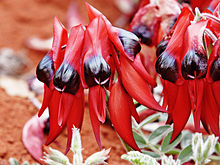Swainsona formosa
| Sturt's Desert Pea | |
|---|---|
 |
|
| Sturt's Desert Pea, at Melbourne Zoo | |
| Scientific classification | |
| Kingdom: | Plantae |
| (unranked): | Angiosperms |
| (unranked): | Eudicots |
| (unranked): | Rosids |
| Order: | Fabales |
| Family: | Fabaceae |
| Subfamily: | Faboideae |
| Tribe: | Galegeae |
| Genus: | Swainsona |
| Species: | S. formosa |
| Binomial name | |
|
Swainsona formosa (G. Don) Joy Thomps. |
|
| Synonyms | |
Swainsona formosa, Sturt's Desert Pea, is an Australian plant in the genus Swainsona, named after English botanist Isaac Swainson, famous for its distinctive blood-red leaf-like flowers, each with a bulbous black centre, or "boss". It is one of Australia's best known wildflowers. It is native to the arid regions of central and north-western Australia, and its range extends into all mainland Australian states with the exception of Victoria.
Specimens of Sturt's desert pea were first collected by William Dampier who recorded his first sighting on 22 August 1699. These specimens are today in the Fielding-Druce Herbarium at Oxford University in England.
The taxonomy of Sturt's desert pea has been changed on a number of occasions. It was initially treated in the 18th century in the genus Clianthus as Clianthus dampieri, and later became more widely known as Clianthus formosus (formosus is Latin for "beautiful"). However it was later reclassified under the genus Swainsona as Swainsona formosa, the name by which it is officially known today.
A further reclassification to Willdampia formosa was proposed in the publication Western Australian Naturalist in 1999; however this proposal was rejected by the scientific community in 2000.
The common name honours Charles Sturt, who recorded seeing large quantities of the flowers while exploring central Australia in 1844; the second version of the scientific name honours the naturalist Isaac Swainson, and the third (rejected) version of the scientific name was intended to honour the explorer William Dampier.
Sturt's Desert Pea is a member of Fabaceae, subfamily Faboideae. It has pinnate, grey-green leaves which are arranged spirally on the main axis of the plant, and in two opposite rows (distichous) on lateral stems. Its flowers are so different from its relatives that it is almost unrecognisable as a member of the pea family. The flowers are about 9 centimetres in length and grow in clusters of around half a dozen on thick vertical stalks (peduncles), which spring up every 10-15 centimetres along the prostrate stems in a bright red, which may be up to 2 metres in length. The sexual organs, enclosed by the keel, comprise 10 stamens, of which 9 are joined and 1 is free, and an ovary topped by a style upon which is located the stigma which receives pollen during fertilisation.
...
Wikipedia
